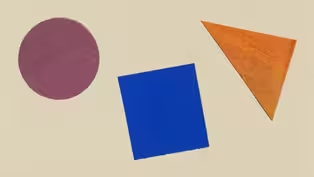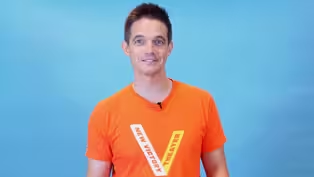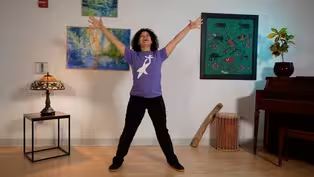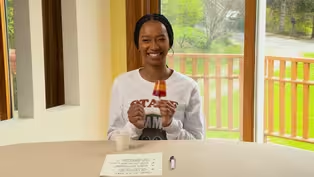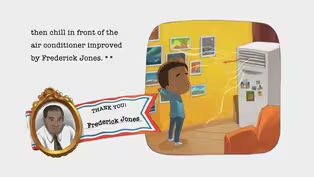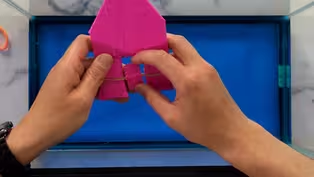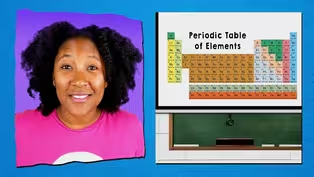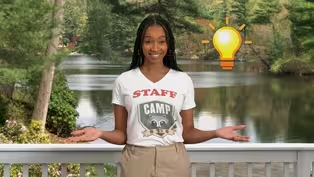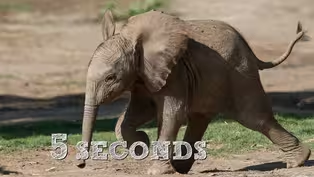
Kid Inventor Day
6/30/2023 | 26m 58sVideo has Closed Captions
Learn about real kid inventors and how to juggle; make a rubber band-powered boat.
Learn about real kid inventors and how to juggle; make a rubber band-powered boat. Welcome to CAMP TV – a half-hour day camp experience in your living room! Head counselor Zing Ashford guides “campers” as they learn through play. Content partners include Mister C, National Dance Institute, New Victory Theater, San Diego Zoo, Story Pirates, WFSU.
Problems playing video? | Closed Captioning Feedback
Problems playing video? | Closed Captioning Feedback
Camp TV is a local public television program presented by THIRTEEN PBS

Kid Inventor Day
6/30/2023 | 26m 58sVideo has Closed Captions
Learn about real kid inventors and how to juggle; make a rubber band-powered boat. Welcome to CAMP TV – a half-hour day camp experience in your living room! Head counselor Zing Ashford guides “campers” as they learn through play. Content partners include Mister C, National Dance Institute, New Victory Theater, San Diego Zoo, Story Pirates, WFSU.
Problems playing video? | Closed Captioning Feedback
How to Watch Camp TV
Camp TV is available to stream on pbs.org and the free PBS App, available on iPhone, Apple TV, Android TV, Android smartphones, Amazon Fire TV, Amazon Fire Tablet, Roku, Samsung Smart TV, and Vizio.
Providing Support for PBS.org
Learn Moreabout PBS online sponsorship♪♪ -Major funding for "Camp TV" was made possible by the... Additional funding was provided by the... [ Upbeat tune plays ] -♪ Camp TV ♪ ♪ It's time for us to start ♪ ♪ From furry animal encounters ♪ ♪ To summer reading and the arts ♪ ♪ No matter what the weather ♪ ♪ We'll explore it all together ♪ ♪ It's a place for you and me ♪ ♪ It's Camp TV ♪ What do earmuffs, water skis, and flippers all have in common?
Other than being awesome, of course.
They were invented by someone just like you, a kid, and these inventions are just some of the things that we use today that were dreamed up by, uh, you.
But first, what is an invention, and how does one go about making one?
An invention is something that introduces a new way of doing things or improves the way something is done.
It can be made on purpose or by accident.
It can be practical or just for fun.
And inventing something is definitely a process.
It starts with an idea and some brainstorming, which leads to coming up with the design and then building a simple model of your idea called a prototype.
With lots and lots of trial and error, testing, and experimentation, changes and improvements are made before it's considered final.
Throughout history, we have kids to thank for innovating, experimenting, and using their imaginations to make life more fun.
Take flippers, for example.
Benjamin Franklin, one of the leading inventors from early American history, loved to swim, and when he was just 11 years old, he decided he wanted to figure out a way to swim faster.
He began experimenting with a pair of wooden paddles that he built called swim fins.
Young Ben discovered when he attached them to his hands and feet, he was able to move through the water more quickly.
Ben Franklin's discovery eventually led to the swim flippers we know and love today.
Another, more modern inventor?
Look no further than Abbey Fleck.
When Abbey was 8 years old, she was making breakfast with her family, and they ran out of paper towels to blot up grease from their morning bacon.
Abbey wanted to find a better way to cook her bacon, one that wouldn't require any blotting at all.
She wondered, "What if you could just hang it kind of like laundry drying so that the fat drips down on its own?"
With her father's help, she built a prototype that eventually led to her invention, the Makin' Bacon, a kitchen gadget used in the microwave where the bacon hangs and the grease collects in a dish below as it cooks.
So do you have an idea for something new?
Is there a problem you'd like to solve?
Well, then you've come to the right place.
Because today is Kid Inventor Day on "Camp TV."
We're celebrating the achievements of kid inventors from the past, present, and future, including you, so get dreaming.
Oh, and get going.
It's time for your first activity.
See you in a few.
Jump, dance, play.
It's time to get active.
Let's Move.
-Hi, I'm Jessi.
I'm an NDI teaching artist.
Today I'm joined by our incredible musician, Yakir.
Let's warm up.
Feet together.
Hands at your side.
Five, six.
Bend your knees.
[ Piano playing ] Onto your tippy toes.
Do that again.
Onto your tippy toes.
Now see if you can make your hands do the same.
Down.
And up.
Down.
And up.
Last one.
Feet apart.
Shoulders go up, down.
Up, down.
Up, down.
Side to side.
Right.
Left.
Right.
Can you go twice as fast?
Take this all the way to the basement.
Top floor.
Basement.
Top floor.
How low can you get?
So tall.
And down.
And up.
Shake an arm out.
Shake.
Other arm.
One leg.
Other leg.
One arm.
Other arm.
One leg.
And the other leg.
Shake your head.
And your shoulders.
Just your ribs.
And your hips.
Your knees.
Just your toes.
Shake everything.
Freeze.
Jump up and down.
Side to side.
Middle.
Forward.
Back.
Crisscross your feet.
Add the arms.
Hop right.
And left.
Stand tall.
[ Exhales sharply ] Arms out.
Let's find a balance.
One leg up.
Hands to knee.
To shoulders.
Head.
And down.
Other side.
Pat your head while you rub your belly.
Put it down.
Deep breath.
[ Breathes deeply ] Make a big "X."
Little "O."
[ Exhales sharply ] Big "X."
Little "O."
[ Exhales sharply ] Big "X."
And "O."
Slowly, arms come up.
And twinkle down the middle.
And find finish as you stand so tall.
♪♪ Thanks so much for warming up with us.
We'll see you next time.
-You took the words right out of my mouth.
Write On.
-Today, we'll be working on made-up inventions.
Well, mostly made-up inventions.
-Lindsey, what do you mean when you say mostly made-up?
-Do you remember that cool invention that you imagined yesterday?
-Oh, you mean the thingy made out of what do you call it and stuff?
-I thought of a way that you can make your invention sound even cooler by using words inspired by real science.
That's why it's just mostly made-up.
-Where do we start?
-How about we start with the periodic table of elements?
This is a real chart that scientists use.
Maybe you've heard that everything in the world is made up of these teeny, tiny things called atoms.
Well, this chart is a list of every single atom that's ever been discovered in the world.
And each of these things does different, but really fascinating things.
-Whoa.
Lindsay, I can't believe all of these words are real.
They look so weird.
Like, what is neon?
-Oh, well, neon is a gas that's used to create colorful lights.
-Oh.
Or helium?
-Well, that's what we use to put in balloons to make them float.
-Oh.
Or what about go-old?
-It's pronounced "gold," and, well, it's gold.
[ Chuckles ] But we don't need to know any of that.
We just need to pick two of these weird but real names.
Like titanium.
[ Ding! ]
-Ooh.
Well, how about fluorine?
-Now let's put those two words together to create a brand new made-up word.
-Fluum.
No.
Um... Titanorine.
No.
No, no, no.
[ Gasps ] Fluoranium.
Yes.
Fluoranium.
-Great.
And since we just made it up, it can do anything.
What do you imagine fluoranium can do?
-I think fluoranium is as bright as 300 suns and smells just as delicious as fresh apple pie.
-And if we add it to your invention, then your invention can become... -A fluoranium beam.
That's the most powerful and delicious-smelling light in the whole universe.
Use it to light up the darkest of spaces or the stinkiest of rooms.
-Now, that's an awesome invention.
-Apple-solutely.
[ Both chuckle ] -Now it's your turn.
Draw a new invention, and you can use the real names from the periodic table of elements, which your grown ups or teachers can help you find, to inspire you to come up with made-up words to help you describe what your invention can do.
See you next time.
Bye.
-A little birdie told me it's time to go wild.
♪♪ ♪♪ [ Bell rings ] -It's a naked mole-rat.
Take a guess at what this is.
[ Bell rings ] This is a stick insect.
Some species of stick insects walk in a swaying motion to mimic a twig moving in the wind.
[ Bell rings ] It's a hummingbird.
Let's take a moment to recap.
-Welcome back to Kid Inventor Day on "Camp TV."
Earlier, we talked about some cool inventions created by kids, but there's one that's arguably cooler than most -- the ice pop.
This delicious dessert was invented by an 11-year-old kid.
And the best part?
It was totally by accident.
One freezing night in 1905, Frank Epperson forgot his drink outside.
The next morning, Frank discovered his happy mistake.
His drink was hard as ice, and after taking one lick, he knew he was on to something yummy.
Frank shared his newfound concoction with friends at school, and they loved it just as much as he did.
Eventually, when Frank got older, he sold his ice pops at a local amusement park, and the rest was history.
Hmm.
Now I'm kind of craving an ice pop.
But not just any ice pop.
A "Camp TV" multi-layered ice pop.
Let's make one.
You will need some small paper cups, wooden craft sticks, and three different kinds of drinks for three different colored stripes.
I'm using cranberry juice, orange juice, and grape juice, but you can feel free to use any kinds of drinks you like.
And to keep track of my steps, I've made a checklist.
To start, let's divide the cup into roughly three different sections.
That way we'll know how much juice to use for the first layer.
Now we're going to pour our first drink about 1/3 of the way up, leaving about 2/3 of room on top.
Put it in the freezer for at least 30 minutes until the layer has started to freeze but isn't quite solid.
This is going to be delicious.
Remove your cup from the freezer and insert a wooden craft stick.
Then return your cup to the freezer until the layer is solid.
Won't be long now.
Next, add the next layer of liquid on top, leaving 1/3 layer on top.
Then you put it back in the freezer until it's frozen solid.
How long will depend on the thickness of the layer.
I can't wait.
[ Chuckles ] Once the second layer is frozen, add your last third to the top.
♪♪ [ Gasps ] It's time.
Peel away the paper and... [ Gasps ] Mmm!
Yum!
[ Chuckles ] Curiosity and wonder.
Let's discover together.
Science Wow!
-Today we're building houseboats with cardboard, duct tape, and rubber bands.
Let's think about the engineering design process.
First we design, then we build, then we test.
How will you design your boat?
Can you get your boat to float?
How far can you get your boat to travel on the water?
There's my design.
Kind of looks like a house.
I've got my propeller that's going to propel my boat forward, and I'm going to use a rubber band to store energy and then make it spin.
Let's get to building.
I'm going to use some duct tape because it's kind of waterproof.
Now it's time to test our houseboat.
♪♪ [ Laughs ] That was cool.
-Music, dance, magic, and more.
Step right up to Center Stage.
-Hello.
My name is Ben Johnson.
I'm a teaching artist with the New Victory Theater.
And today we're going to explore the ancient/modern/futuristic art of juggling.
People have been throwing things up in the air and catching them for a long, long time.
In fact, folks were juggling back in ancient Egypt, China, Greece, Mesoamerica, and juggling is alive and well today.
The other day I saw this kid in the park who was trying to see how many leaves he could keep up in the air.
And maybe in the future, an astronaut will juggle 36 rocks on the surface of the moon.
We see people juggling most often scarves, balls, and clubs.
But not everyone has juggling scarves, balls, and clubs laying around the house.
Luckily, there are some easy substitutions we can make.
Instead of scarves, you could use plastic bags.
Instead of balls, you could use tennis balls or fruit or priceless Fabergé eggs.
And instead of clubs you could try to juggle some folded-up umbrellas.
But for now, let's focus on one -- plastic bags.
We're going to divide our exploration of plastic-bag juggling into three levels.
For level one, you need just one bag.
Everyone got it.
Hold it right here in one hand, about as high as your waist, and you're going to throw it back and forth between your hands five times.
Ready, set, go.
One, two, three, four, five.
Do you got it?
Alright.
For the bonus challenge, try this.
Throw it up in the air, and see how many times you can clap without letting it hit the floor.
Ready, set, go.
One, two, three, four, five, six.
Ah.
Level two.
Two plastic bags.
Take them in, one in each hand.
Hold them about as high as your waist is.
And then you're going to try to make an "X" pattern in front of your body.
Like this.
Throw, throw, catch, catch.
Throw, throw, catch, catch.
Try to do that five times.
Ready, set, go.
One.
Two.
Three.
Four.
Five.
And for the extra bonus challenge, try this.
Put one hand like this, the other bag like that.
Take this hand.
Put it behind your back.
Now try to keep both of these bags in the air using only one hand.
Ready, set, go.
[ Exhaling sharply ] For level three, you're going to need three plastic bags.
Take the first one.
Hold it in your pinky, like that.
Take the second one.
Hold it with your index finger and your middle finger, like that.
And take the third bag and hold it in your other hand.
Now, here's a challenge.
Try to juggle all three of these bags in the "X" pattern in front of your body five times.
Alright.
One, two, three, four, five.
Ah.
If you're ready for a bonus round, try this out.
Same beginning.
Pinky finger.
Index, middle.
Other hand.
Juggle in the same pattern.
And at some point, throw one super high, spin around, and then catch it.
♪♪ ♪♪ That is all for now.
Thank you so much for taking some time and hanging out and juggling with me today.
And best of luck as you practice, practice, practice and maybe someday start your own circus.
Have fun.
We'll see you next time.
-Arts and crafts?
Yes, please.
Let's Get Artsy.
-Shapes are flat or two-dimensional areas of an artwork.
That means that they have height and width but no depth.
Shapes can be made when a line crosses over itself or closes... ...or when a line is so thick that it actually becomes a shape.
They can also be defined by some sort of contrast, like a difference in color or value.
Shapes can be geometric and precise, like circles, squares, and triangles, or they can be organic and irregular.
-Daytime or nighttime, it's always time for story time.
Ready for just the right book read by just the right camper?
Without further ado, take it away.
-Hi, everyone.
My name is Kaden.
Today I'm going to be reading a book called "Have You Thanked an Inventor Today?"
by Patrice McLaurin, illustrated by Dian Wang.
Let's get started.
"This world is full of inventions.
Some of them we don't even think about.
But if we took time to think about them, we'd realize we wouldn't want to live without them.
You see, inventions, they make our lives much easier, and they also make our lives more fun.
So we should thank the inventors who invent great inventions, for without them, we might not get anything done.
Like, for instance, when your mom wakes you up in the morning to let you know that it is time for school.
You stretch and yawn, rub the corners of your eyes, and probably wipe away last night's drool!
That's when you happen to glance over at your clock and realize you're running a bit late.
But you wouldn't know that if it weren't for Benjamin Banneker.
He invented the first clock in the United States.
So you put your clothes on and rush into the bathroom.
You wash your face and brush your teeth, then brush your hair.
Be sure to thank Lyda Newman for part of your morning grooming, as the modern-day hairbrush was her awesome idea.
Afterwards, you're called into the kitchen for breakfast.
This morning is cereal with fruit and wheat toast.
Thank goodness John Stanard improved a refrigerator because hot milk with your cereal is pretty darn gross.
And when you're on your way to school, whether you're a bus rider, a car rider, or you walk, you have to think Garrett Morgan for the traffic light.
Otherwise, none of our streets would be safe to cross.
Then, after you settle into your classroom, and you've taken out your supplies because you're such a scholar, please remember to show love to Mr. John Love, for his invention was none other than the pencil sharpener.
Now, as much as you love to learn, you'll admit that sometimes lunch is your favorite time of the day.
Well, you can thank John Robertson for your lunch box, but for inside it, it's your mom who you should thank.
And what does your mom usually pack in your lunch box?
Tasty snacks that make your belly go yum like peanut butter, made popular by George Washington Carver, or potato chips invented by George Crumb.
Fast forward.
The school day is now over.
It's been a long one, and you're happy to be home.
You check the mailbox invented by P. Downing, then chill in front of the air conditioner improved by Frederick Jones.
Plus, your teacher didn't assign any homework, so you decide to play a few games on the cellphone.
Well, if it wasn't for Henry Sampson's gamma-electric cell, believe it or not, there would be no cellphone.
And these are just a few awesome inventions.
There are countless that I didn't even mention, like the doorknob invented by O. Dorsey or a type of guitar invented by Robert Flemming.
Sarah Boone invented the ironing board, and Thomas Stewart invented the mop.
Lonnie Johnson invented the Super Soaker, and W.A.
Martin improved the lock.
So here's a cool thing for you to do.
You should take a moment or two and ponder over how life would be if these inventions weren't created for you.
Then, as you lie in your bed this evening and think about how your day was spent, don't forget to thank an inventor.
Then dream about what you'd like to invent."
The end.
Thanks for reading with me.
Bye.
♪♪ -♪ Camp TV ♪ ♪ It's time for us to part ♪ ♪ From furry animal encounters ♪ ♪ To summer reading and the arts ♪ ♪ No matter what the weather ♪ ♪ We'll explore it all together ♪ ♪ It's a place for you and me ♪ ♪ It's Camp ♪ ♪ T ♪ ♪ V ♪ -Major funding for "Camp TV" was made possible by the... Additional funding was provided by the...
Content provided by the following... ♪♪ ♪♪ ♪♪ ♪♪ ♪♪
Video has Closed Captions
Clip: 6/30/2023 | 40s | What defines a shape? Find out with the Children's Museum of Manhattan. (40s)
Video has Closed Captions
Clip: 6/30/2023 | 3m 50s | Discover juggling activities that use everyday items at New Victory Theater! (3m 50s)
Video has Closed Captions
Clip: 6/30/2023 | 3m 5s | Warm up your whole body through dance with Jessi from the National Dance Institute! (3m 5s)
Video has Closed Captions
Clip: 6/30/2023 | 2m 58s | Make a Camp TV multi-layered ice pop with Zing! (2m 58s)
Read Aloud: “Have You Thanked an Inventor Today?"
Video has Closed Captions
Clip: 6/30/2023 | 4m 6s | Kaden reads “Have You Thanked an Inventor Today?” by Patrice McLaurin. (4m 6s)
Rubber Band Boat Engineering Design Challenge
Video has Closed Captions
Clip: 6/30/2023 | 48s | Follow the engineering design process with Mister C as we build a model houseboat! (48s)
Story Pirates University: Made Up Inventions
Video has Closed Captions
Clip: 6/30/2023 | 3m 7s | Learn how to use real words from science to make your made up inventions sound real! (3m 7s)
Theme of the Day: Kid Inventor Day
Video has Closed Captions
Clip: 6/30/2023 | 2m 40s | Welcome to Kid Inventor Day on Camp TV! Some great inventions were invented by kids! (2m 40s)
Video has Closed Captions
Clip: 6/30/2023 | 2m 38s | Learn fun creature facts with this guessing game from the San Diego Zoo Wildlife Explorers (2m 38s)
Providing Support for PBS.org
Learn Moreabout PBS online sponsorshipSupport for PBS provided by:
Camp TV is a local public television program presented by THIRTEEN PBS
